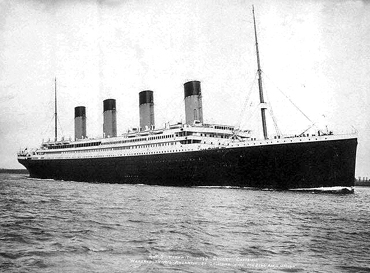It’s been a century since she disappeared beneath the glassy surface of the Atlantic Ocean. Yet she remains the most famous passenger ship in history, her name a symbol of tragedy and of the fallibility of both people and their technology.
The Royal Mail Ship Titanic set sail from Southampton, England, on April 10th, 1912. It was her maiden voyage across the Atlantic, to New York. The luxurious liner -- the largest of her day -- carried more than 2200 passengers and crew.
 RMS Titanic. Credit: Wikipedia.
RMS Titanic. Credit: Wikipedia.As she neared the Grand Banks off the coast of Canada, her captain received warnings of icebergs. He turned the ship slightly southward, toward what he expected to be clear waters.
On the night of April 14th, though, Titanic struck an iceberg. The great liner sank in just two-and-a-half hours, with the loss of more than 1500 lives.
The tragedy quickly led to new safety regulations. It also led to the creation of a service that keeps an eye on the North Atlantic shipping lanes.
The service began within weeks, when the U.S. Navy dispatched two cruisers to spot icebergs and warn other ships of the danger. Two years later, the International Ice Patrol was established to continue the work -- which continues today.
In the early days, oceanographers went to sea with the patrol’s ships, and made important discoveries about currents in the North Atlantic. They greatly increased our knowledge of the oceans -- while helping many more ships avoid the fate of the most famous oceanliner in history: Titanic.

